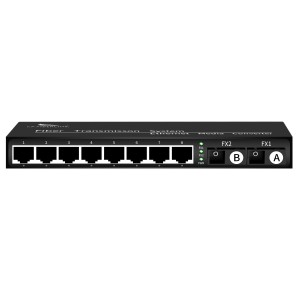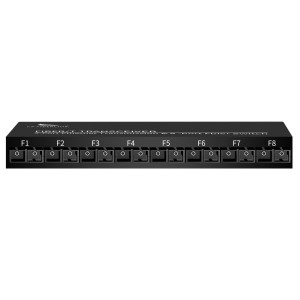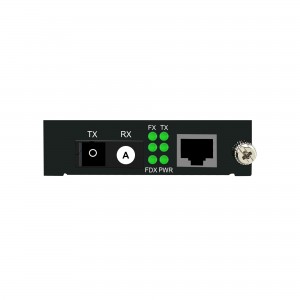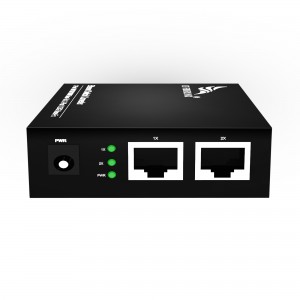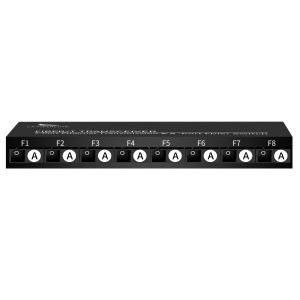2-port 10/100/1000M WDM Media Converter (Single-mode Single-fiber SC)
2-port 10/100/1000M WDM Media Converter (Single-mode Single-fiber SC)
Product Features:
Introducing the Card 1 Optical 1 Electrical Single Mode Single Fiber End, your ultimate solution for seamless Fiber to Ethernet connections. Developed by Huizhou Changfei Optoelectronics Technology Co., Ltd., a leading manufacturer of industrial communication products, this innovative device offers unrivaled reliability and performance.
At Huizhou Changfei, we pride ourselves on being able to provide cutting-edge technology to meet the ever-changing needs of our valued customers. With a rich product portfolio of cloud-managed industrial switches, PoE switches, Ethernet switches, fiber optic transceivers, wireless transmission equipment, etc., we are always committed to providing users with comprehensive solutions and high-quality services.
Card type 1 optical 1 electrical single-mode single-fiber end is one of our latest products specially designed for industrial Ethernet fiber conversion. Its compact yet robust iron case design ensures durability and longevity, making it ideal for use in harsh industrial environments. The device is also IP30 rated for extra protection against dust and debris.
We understand the importance of power efficiency in modern industrial applications. That’s why our card type 1 optical 1 electrical single mode single fiber end features low power consumption to minimize your energy costs while maintaining peak performance. In addition, it also supports external power supply, allowing you to choose the installation method flexibly.
When it comes to connectivity, the device stands out from the competition. Card-type 1 optical 1 electrical single-mode single-fiber end can realize seamless transmission between optical fiber and Ethernet, ensuring reliable high-speed transmission of data. With its single-mode single-fiber A-end, it provides a simplified solution for your network needs.
As industrial communication experts, we understand the importance of reliability and the need for uninterrupted connectivity. The snap-on 1 optical 1 electrical single-mode single-fiber tip is carefully designed to provide excellent performance and ensure stable and secure data transmission in any industrial environment.
Whether you need to establish a fiber-to-Ethernet connection in a manufacturing plant, a power station, or any industrial facility, our Cassette 1 Optical 1 Electrical Single Mode Single Fiber End is your go-to solution.
At Huizhou Changfei, we are committed to driving innovation and providing customers with cutting-edge products. Our team of dedicated experts is constantly pushing the boundaries and developing new solutions to meet the ever-changing industrial landscape. With our wide range of products, solutions and overall services, we strive to be your trusted industrial communication partner.
Experience the power of seamless fiber-to-Ethernet transitions with the 1 Optical 1 Electrical Single Mode Single Fiber End in a Box. Believe that Huizhou Changfei Optoelectronics Technology Co., Ltd. can provide world-class industrial communication solutions for your business needs. Contact us today to find out how our products can revolutionize your connectivity needs.
What This Product Does
◇ CF-101GSK-3A is a gigabit media converter, providing a gigabit RJ-45 port and a gigabit SC fiber port, which can convert between electrical and optical signals.
How This Product Works
◇ CF-101GSK-3A adopts WDM (wavelength division multiplexing) technology, helping send and receive data at a distance of up to 3 km with only a single mode fiber, which saves half of the cable deployment cost for customers. CF-101GSK-3A transmits data at 1310 nm wavelength and receives data at 1550 nm wavelength on optical fiber. Therefore, the terminal device used in conjunction with the CF-101GSK-3A should send data at a wavelength of 1550 nm and receive data at a wavelength of 1310 nm. CF FIBERLINK another media converter CF-101GSK-3B is one of the products that can cooperate with CF-101GSK-3A.
Other Features
◇ Besides, this media converter can be used as a standalone device (no rack required) or used with CF FIBERLINK’s CF-2U16 rack for auto MDI/MDI-X in TX port in which duplex mode is automatically negotiated.
technical parameter:
|
Model |
CF-101GSK-3A | |
| Interface Characteristics | ||
|
Fixed Port |
1* 10/ 100/ 1000Base-T RJ45 port 1* 1000Base-X uplink SC fiber port |
|
|
Ethernet Port |
10/ 100/ 1000Base-T auto-sensing, full/half duplex MDI/MDI-X self-adaption |
|
|
Twisted Pair Transmission |
10BASE-T: Cat3,4,5 UTP(≤100 meter) 100BASE-T: Cat5e or later UTP(≤100 meter) 1000BASE-T : Cat5e or later UTP(≤100 meter) |
|
| Optical Port | Default optical module is single-mode single-fiber 3km, SC port | |
| Wavelength/Distance | A-end: RX1310nm / RX1550nm 0 ~ 40KM
B-end:RX1550nm/ RX1310nm 0 ~ 40KM |
|
| A-end: RX1490nm / RX1550nm 0 ~ 120KM
B-end:RX1550nm/ RX1490nm 0 ~ 120KM |
||
| Chip Parameter | ||
| Network Protocol | IEEE802.3 10BASE-T, IEEE802.3i 10Base-T,
IEEE802.3u 100Base-TX, IEEE802.3u 100Base-FX, IEEE802.3x IEEE802.3ab 1000Base-T;IEEE802.3z 1000Base-X; |
|
|
Forwarding Mode |
Store and Forward(Full Wire Speed) |
|
|
Switching Capacity |
4Gbps |
|
|
Buffer Memory |
3Mpps | |
|
MAC |
2K | |
|
LED Indicator |
Fiber | FX(green) |
| Data | TP (green) | |
| Single / duplex | FDX (green) | |
| Power | PWR (green) | |
| Power | ||
| Working Voltage |
AC:100-240V |
|
|
Power Consumption |
Standby<1W, Full load<5W |
|
|
Power Supply |
DC:5V/2A industrial power supply |
|
| Lightning protection &Certification | ||
| Lightning protection | Lightning protection: 4KV 8/20us, Protection level: IP30 | |
| Certification | CCC;CE mark, commercial; CE/LVD EN60950;FCC Part 15 Class B; RoHS | |
| Physical Parameter | ||
| Operation TEMP | -20~+55°C;5%~90% RH Non condensing | |
| Storage TEMP |
-40~+85°C;5%~95% RH Non condensing |
|
| Dimension (L*W*H) | 98mm*75mm*2mm | |
| Installation | Desktop, CF-2U16 slot rack | |
Product Size:
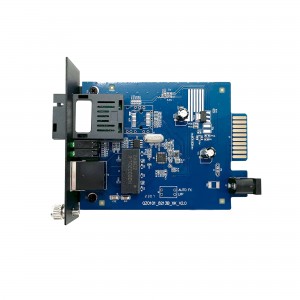
Product application diagra:

How to choose a fiber optic transceiver?
Optical fiber transceivers break the 100-meter limitation of Ethernet cables in data transmission. Relying on high-performance switching chips and large-capacity caches, while truly achieving non-blocking transmission and switching performance, they also provide balanced traffic, isolation and conflict. Error detection and other functions ensure high security and stability during data transmission. Therefore, fiber optic transceiver products will still be an indispensable part of actual network construction for a long time. So, how should we choose fiber optic transceivers?
1. Port function test
Mainly test whether each port can work normally in the duplex state of 10Mbps, 100Mbps and half-duplex state. At the same time, it should be tested whether each port can automatically select the highest transmission speed and automatically match the transmission rate of other devices. This test can be included in other tests.
2. Compatibility test
It mainly tests the connection ability between the optical fiber transceiver and other devices compatible with Ethernet and Fast Ethernet (including network card, HUB, Switch, optical network card, and optical switch). The requirement must be able to support the connection of compatible products.
3. Cable connection characteristics
Test the fiber optic transceiver’s ability to support network cables. First, test the connection ability of Category 5 network cables with lengths of 100m and 10m, and test the connection ability of long Category 5 network cables (120m) of different brands. During the test, the optical port of the transceiver is required to have a connection capability of 10Mbps and a rate of 100Mbps, and the highest must be able to connect to a full-duplex 100Mbps without transmission errors. Category 3 twisted pair cables may not be tested. Subtests can be included in other tests.
4. Transmission characteristics (transmission loss rate of data packets of different lengths, transmission speed)
It mainly tests the packet loss rate when the optical fiber transceiver optical port transmits different data packets, and the connection speed under different connection rates. For the packet loss rate, you can use the test software provided by the network card to test the packet loss rate when the packet size is 64, 512, 1518, 128 (optional) and 1000 (optional) bytes under different connection rates. , the number of packet errors, the number of packets sent and received must be more than 2,000,000. Test transmission speed can use perform3, ping and other software.
5. The compatibility of the whole machine to the transmission network protocol
It mainly tests the compatibility of fiber optic transceivers to network protocols, which can be tested in Novell, Windows and other environments. The following low-level network protocols such as TCP/IP, IPX, NETBIOS, DHCP, etc. must be tested, and the protocols that need to be broadcast must be tested. Optical transceivers are required to support these protocols (VLAN, QOS, COS, etc.).
6. Indicator status test
Test whether the status of the indicator light is consistent with the description of the panel and the user manual, and whether it is consistent with the current status of the fiber optic transceiver.








